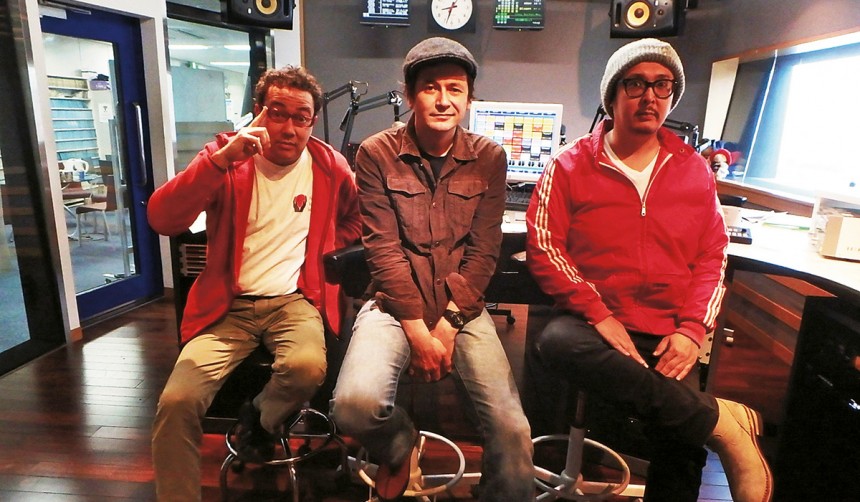
February 24, 2016
What the Funday?
Rock radio power trio on FM’s bleak future in Japan
MCs George, Mike, and Taro are one of Japanese radio’s most enduring—and irreverent—lineups. For years, they’ve hosted different rock shows on InterFM, becoming a turn-to source in Japan for new music by breaking acts. Metropolis heard from producer Mike Rogers about their current show What The Funday? and their battles against the dire state of FM radio in Japan.
How did you come to host a rock radio show in Japan?
I started in 1980 as an assistant for Rodney on the Roq at KROQ Los Angeles. As a team, we’ve been doing this since 1994 or so. I wrote a planning sheet for a rock program and turned it in to several radio stations. It was a plan for radical radio that was like the rock programs I loved as a kid. When I was a teenager, I’d actually rush home and turn the radio on so that I could tune in to certain programs.
What are the main differences between rock radio in Japan and overseas?
Japanese radio today is like American AM radio in the 1940s and 1950s; they still have block programming, which means you can tune into a station at different times and hear completely different types of music. For example, at 5pm they’re playing rock music; at 8pm, they are playing jazz. Or, they’re playing the Japanese version of the “Hit Parade [from] Hell” that you see on all those big screens at Shibuya Crossing, which consists of teenybopper boy and girl bands. Of course, being a “musicologist,” I give those Japanese idol groups “two thumbs up!” … yeah, two thumbs up to gouge my eyes out so that I don’t have to see them anymore.
Tell us about the dynamic between you three and what keeps you together.
I have been George Williams’ agent for nearly 25 years. It has been my job to find him good show-business gigs, but to also make jobs that help him keep a cool image, and to keep him—for lack of a better term—the leader in new music. Taro joined into a show called Channel G in 1996, and it just clicked from there. The show has continued under different names and times, but it’s basically the same show—brand-new music aired before anyone else in Japan. I see George Williams as the Jon Stewart of the show, and Taro and I are the crazy reporters who bring in stuff from deep outfield.
Tell us how the current program has evolved.
The shows basically all have the same plan: no script, and we talk about real things and what is happening now. Japanese radio is so full of nonsense conversations. Why do I have to do like 99 percent of the shows and ask people questions like, “What is your favorite bento?”
To what extent do you select your own material? How much is format-driven?
I select most of the music, but the guys sometimes help out too. I try to pick at least 10-12 brand-new underground artists that are happening in the U.K., America, or even Japanese indies to air every week. Most of the bands we play fade into oblivion, but I can brag that we were the first to play many acts in Japan before they became big. The most famous of [these] were Amy Winehouse and The White Stripes.
What kind of rock are young Japanese interested in these days?
Young Japanese people don’t really listen to rock music; they listen to EDM. Just go to something like Fuji Rock or even your local rock club; you will see very few 20-somethings in the audience these days.
How do you see the future of FM radio in Japan?
In April, I started working on a project for Nico Nico Douga [Japan’s YouTube]. The show we made, Ninja Slayer, had over 10 million views in six months. I took that job because I could see the writing on the wall. At a meeting with one of Japan’s biggest publishers, they presented data on viewing and listening habits.
I was shocked. Of over 20,000 Japanese youth between 16 and 28, only 11 percent had a TV in their bedroom; a mere 5.6 percent had an FM radio. An astounding 97 percent had a smart device. When I was a kid, I would sneak [into] bed and listen to the radio. Kids today snuggle up with their iPhone and watch the videos and music they want to watch; today’s young people do not listen to the radio.
So when people under 30 don’t care about you, what [does] your future look like? We’re witnessing the slow-motion train wreck of FM radio in Japan. Just like the big Japanese TV stations, unless something is done to focus on a target market, there is no way they can survive in their current configuration.
Mike Rogers’ Top 6 Japanese Rock Bands
The Neatbeats: The Japanese Beatles. Hilariously awesome entertainment.
The Privates: The Japanese Buzzcocks. Been around for 30 years and still kicking it.
The 50 Kaitenz: These guys are Japan’s funniest and most entertaining punk band.
Su凸ko D凹koi: Pronounced “suttoko dokkoi.” Brand-new Tokyo girl-punk trio. Imagine if NOFX were a group of cute Japanese girls who also happened to be awesome musicians.
The Routes: A band from Kyushu … that is fronted by a gaijin? Getting tons of airplay all around the world! In Japan? Only on my show.
Taffy: Awesome Tokyo band. Shoegazer and ’90s Britpop better than the Brits could ever do.







